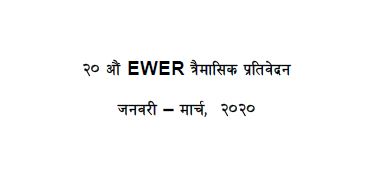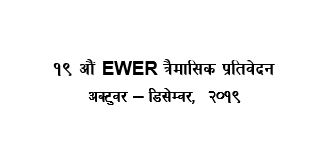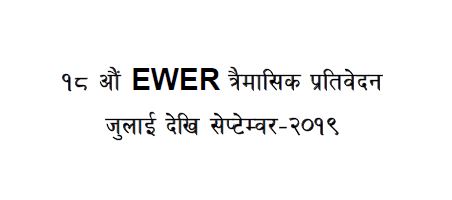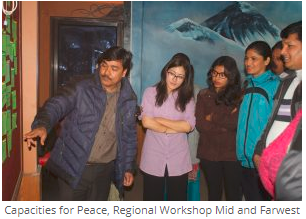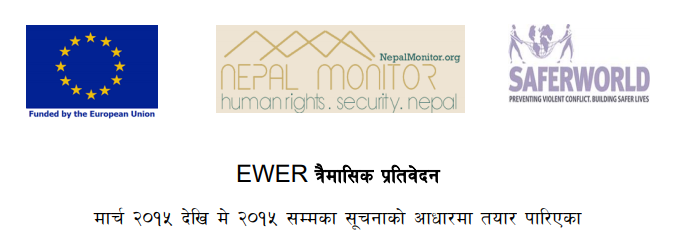Incident Reports
बेपत्ता छानबिन आयोगले अषाध १ गते देखी आयोगमा परेका उजुरीहरुमा काम थाल्ने निर्णय
2016-03-22
दशकौं लामो सशस्त्र द्वन्द्वबाट पीडितको गुनासो खोजेका प्रवर्तित बेपत्ता पारिएका व्यक्तिहरूको अनुसन्धान आयोगले जून १५ देखि उजुरीमाथि विस्तृत छानबिन सुरु गर्ने लक्ष्य राखेको छ। यद्यपि आयोगले प्राथमिक जानकारी गराएको छ पीडित र तिनका परिवारबाट गुनासो प्राप्त भएपछि अनुसन्धान सुरु हुनेछ। यदि हो भने, सीआईईडीपीका अनुसन्धान प्रक्रिया के हुनेछ? सीआईईडीपीका प्रवक्ता डा.विष्णु पाठकका अनुसार आयोगले अनुसन्धान डिभिजन गठन गरेको छ र डिभिजनले सर्वप्रथम केन्द्रीय कार्यालयमा र जिल्लामा स्थानीय शान्ति समितिका माध्यमबाट प्राप्त उजुरीको बारेमा छानबिन गर्नेछ। "यो युगको युगमा फेब्रुअरी १३, १९९६ देखि नोभेम्बर २१, २००६ सम्म लागु गरी बेपत्ता पारिएका घटनाहरूका बारे छानबिन गर्न आयोग गठन गरिएको थियो। सर्वप्रथम, अनुसन्धान शाखाले प्राप्त गरेको उजूरी सम्बन्धित छ कि छैन पत्ता लगाउनेछ। विद्रोह युगको बेपत्ता पारिए वा हुँदैन, "पाठकले भने। उजुरीहरू प्रमाणीकरण गरिसकेपछि आयोगले प्रत्येक वेपत्ता पारिएका व्यक्तिका लागि आइटम्टोरम डाटा फाराम भर्नाका लागि प्रशिक्षित अधिकारीहरूलाई पीडितको घर पठाउँनेछ। पाठकले भने"आयोगले २३-पृष्ठको एन्टि-मोर्टम फारम तयार गरेको छ। यो प्राविधिक छ र प्रशिक्षित अधिकारीहरूले मात्र यसलाई भर्नेछन। यसले बेपत्ता पारिएको व्यक्तिको शारीरिकता र उसको उपस्थितिबारे विस्तृत जानकारी प्रदान गर्नेछ,"। पाठकका अनुसार आयोगले बेपत्ता पार्ने प्रत्येक केसमा सम्भावित अपराधीको बारेमा परिवार र साक्षीको बयान लिने काम सुरु गर्ने छ। यसपछि आयोगले कथित अपराधीको बयान रेकर्ड गर्दछ। "आरोपित अपराधीहरूले कानुनी सल्लाहकारसँग परामर्श लिन सक्दछन् तर उनीहरूले व्यक्तिगत रुपमा बयान दिएका छन् कुनै वकिलको माध्यमबाट होइन," पाठकले भने। यदि पीडितको परिवार, साक्षी र आरोपित अपराधीको बयानले बेपत्ता पारिएको व्यक्तिको मृत्यु भइसकेको भन्ने निष्कर्षमा पुग्दा आयोगले चिहानलाई बाहिर निकाल्नेछ। "सल्लाहकारको काम विशेषज्ञको उपस्थितिमा सञ्चालन गरिनेछ र कार्यको प्रत्येक विवरण रेकर्ड गरिनेछ। अनुसन्धानको तथ्यान्क पत्ता लगाउन खोजिने छ जसको शरीरका अङहरु को हुन् भनेर अन्तिम निर्धारण गर्न सकिन्छ," पाठकले भने। "आयोगले एन्टि-मोर्टम डाटासँग तुलना गरेर यो कसको शरीर हो भन्ने निष्कर्षमा पुग्न सकेन भने हामी डीएनए परीक्षणका लागि पीडितको परिवारको सन्दर्भ नमूना संकलन गर्नेछौं। बाहिरिएका शरीरका अंगहरूलाई डीएनएको लागि विदेशी ल्याबमा पठाउने छौं" पाठकले भने। पाठकका अनुसार आयोगले पीडकलाई कानुनी कारबाही गर्न र परिवारलाई न्यायिक उपचारका लागि महान्यायाधिवक्तालाई पत्र लेख्छ। परिवारलाई क्षतिपूर्ति दिनका लागि आयोगले सरकारलाई पनि लेख्ने छ। पाठकले भने, 'यी प्राविधिक प्रक्रियाहरू बाहेक बेपत्ता पारिएका व्यक्तिहरूको बारेमा जानकारी संकलन गर्न आयोगले सार्वजनिक सुनुवाई गर्नेछ।'
